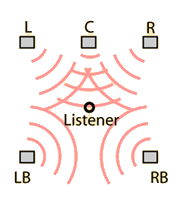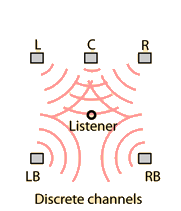Surround Sound
|
Surround sound is a term applied to five channel sound (regular R & L stereo, center front, plus left and right rear speakers). It typically means Dolby Surround, the home application of Dolby Stereo, which was introduced into movie theaters in the 70's. It is a matrix encoding scheme which puts four channels of information on two recorded channels to be decoded into L, R, Center, and Surround upon playback. |  |
A popular adaptation of surround sound for home sound systems is called Dolby Pro-logic. To obtain five discrete channels of information (including separate signals to LB and RB speakers requires digital surround sound.
| Sound synthesis |
Sound reproduction concepts
Audio signal concepts
Reference
Riggs
| HyperPhysics***** Sound | R Nave |
